Meeting Design: Creating Spaces for Leaders to Connect and Learn
The Challenge
Our client, a Learning and Development leader at a financial services firm, was responsible for a two-day meeting for the organization’s top leaders. The group of approximately 130 decision-makers came together to learn about and ratify a new 4-year strategy for the firm. Coming into the meeting, the tension was palpable. Many of the leaders were not clear on how to re-structure their practices to align with the shift in focus. They were also feeling the pressure of managing long lists of priorities coming from every direction - the upper levels of the firm, clients, and team members. It was clear that leaders weren’t ready to buy in to the strategy and they weren’t clear on whether they were supposed to be cooperating or competing with their colleagues.
This challenge was one of developing healthy leaders and a thriving culture. Healthy leaders get the best out of themselves and the people they lead while thriving cultures enable improved engagement and organizational performance.
The Engagement
At sr4, we believe in the human touchpoint. Through meeting design and support, we created an environment where leaders could be humans, first and foremost, so they could let their guard down and feel comfortable talking to each other about how they were being asked to behave differently. Prior to the meeting, we took our time with the client to clarify the context so we could understand the landscape and what people would be thinking and feeling. We defined specific objectives and then crafted the agenda to achieve those objectives. The client wanted to include a guest speaker to introduce new leadership skills, so we found and met with a professor and author who researched enterprise leadership, using perspective-taking, and the knowledge of when to cooperate and compete to lead across an organization. We worked with him to customize his research into a meaningful message for experienced executives who were being asked to lead with an enterprise mindset for the first time. We built in opportunities for the leaders to learn from the CEO, COO, CHRO, and others who defined the strategy. We helped them craft questions to uncover why they felt they needs a new direction, what it was, the plan for implementation, and what they were hoping the top 130 leaders of the firm would do once equipped with it. We designed breakout experiences so participants could gain a deeper understanding of enterprise leadership and discuss how they might help each other exemplify the strategy, create action plans, hold each other accountable, and talk about what they would do differently with their teams when they returned to their home office. One of our simple rules for great meeting design includes having fun, so we included a game night that provided a low-stakes environment for leaders to practice flexing both their cooperation and competition muscles by competing at games like Pop-a-Shot and Air Hockey both as an individual and as a member of a team.
As the meeting approached, we refined our designs with the client and held prep sessions with the firm leaders who were responsible for facilitating. During the meeting, the sr4 team made sure the leaders could be 100% focused on what they were there to do. For example, we made sure: the rooms were set up to support the kinds of discussions the leaders needed to have, speakers and facilitators had what they needed and felt confident about the material they were responsible for delivering, and participant materials were complete, correct and distributed to the right people at the right time.
The Result
As with all of our client’s, we ask for feedback and aim for continuous improvement. After the meeting, we sent a follow-up survey to all participants. The results said that 87% of participants thought the meeting objectives we worked with our client to define at the outset were “quite effectively” or “very effectively” achieved over the course of the meeting, which meant that the firm’s leaders felt like they had a deeper understanding of the strategy and clear expectations for how they were expected to act as enterprise leaders.
The sr4 Insight
Humans crave connection - especially when things are changing. Designing intentional experiences to help leaders connect first as people and then as colleagues can help them see things from new perspectives and gain context and clarity about what to do and how to be most effective. sr4 can help design and support experiences that allow your leaders to focus on what’s most important.

